To my amazement, not everyone with gardens is delighted to find mushrooms and toadstools growing there. Of course many fungi are in gardens anyway, but they are usually unseen until circumstances are right for some species to seemingly spontaneously erupt into fruiting.
Mushrooms and toadstools have probably always evoked ambivalent feelings amongst us. They have a kind of mystery as they appear suddenly and just as suddenly disappear, and although many mushrooms are deliciously edible, some are poisonous and even deadly, so mushrooms may induce delight or dread.

The term mushroom is used quite loosely, but most often refers to fungi that form domed caps on stalks, and the term toadstool generally refers to those that are poisonous. All photos in this post are of these forms of fungi that crop up in our garden from time to time.

Athough there are those who dislike it when mushrooms and other fungi appear in their gardens – with some gardeners even trying to eradicate them – interestingly many plants cannot exist without the existence of fungi.
The diverse group of mycorrhizal fungi live in a mutually beneficial association with plants. The fungi live around the roots of plants in a symbiotic relationship of nutrient transfer – the fungi help bring water and nutrients to the plants roots, and in turn the plant roots provide the fungi with carbohydrates.

The fruiting bodies of fungi that we see, such as in the form of domed mushrooms or toadstools, emanate periodically from the main body of the organism that is hidden from view as it exists in a substrate such as soil or wood. The main part of the fungus is a network of hair-like filaments. The fine filaments are referred to as hyphae, and when they grow together they form the network referred to as the mycelium.
The mycelium of a mycorrhizal fungus surrounds the roots of its host plants, with some hyphae penetrating the roots in the mutually beneficial association. It is estimated that 90 of plant species – that include trees such as oaks and pines – depend on such associations. Specific fungi have co-evolved in association with specific host plants. These relationships can be very specific, so for example foragers of wild edible mushrooms will know to look for specific species of mushrooms in proximity to specific species of trees.

Another grouping of fungi, referred to as saprophytic fungi, feed on dead plant matter, such as wood, or on animal remains. These fungi are important decomposers of organic matter and the decomposition work they do recycles dead plant and animal material into essential components of productive soils, making humus and contributing nutrients and minerals to maintain healthy and fertile soil.
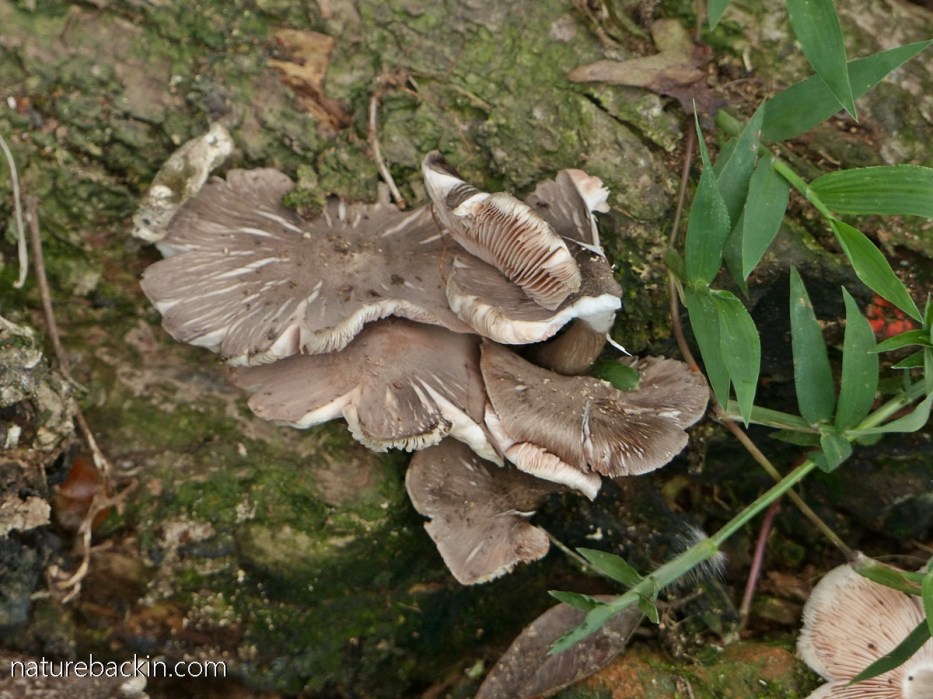
Many of the fruiting bodies of fungi that I see in our garden are associated with decaying wood or roots. The fragile and easily broken caps of the large mushrooms in the photo above emanate from a decaying tree stump. The underneath gills of the mushroom can be seen. The gills are the spore-producing surfaces of these mushrooms.
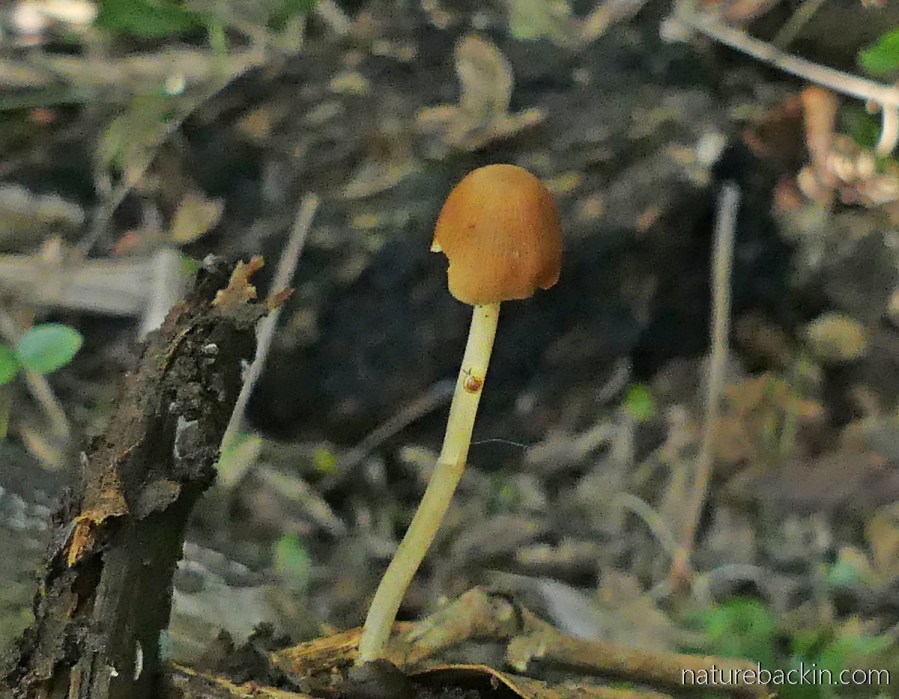
This small mushroom is growing out of decaying bits of wood in the leaf litter left undisturbed under a grove of trees in our garden. A tiny snail is visible on the stem (or stipe) of the mushroom.

I think the mushrooms above are one of the inkcaps. This cluster of mushrooms is also growing out a decaying tree stump.

As suddenly as they appear the mushrooms collapse into an inky ‘mess’ – hence the name ink cap. The gills dissolve into a sticky black liquid or slime and the spores can be spread by water of visiting insects.

Every few months or so, an attractive solitary mushroom appears in the same spot in our lawn. Unfortunately this one got damaged but the damaged area shows off the spore-bearing gills on the underside of the mushroom. I am not attempting to identify the mushrooms featured here as it takes quite some training and attention to detail to be able to do this with any degree of confidence.
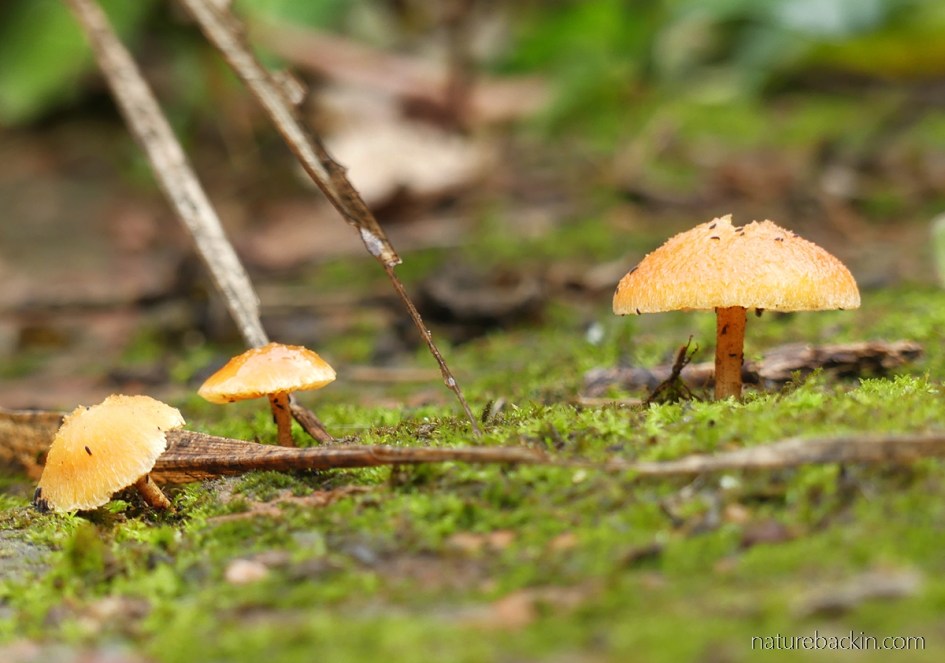
These pale orange mushrooms emerged in the gaps between old moss-covered bricks paving a shady area in our garden. I wondered if red and orange mushrooms are less likely to be edible and if, as in some insects, the bright colours advertise danger. But looking at my field guide to mushrooms I see that some red and orange mushrooms are edible, and that the innocuous-looking pale mushroom known as the ‘death cap’, which is deadly poisonous if eaten, resembles many edible mushrooms.
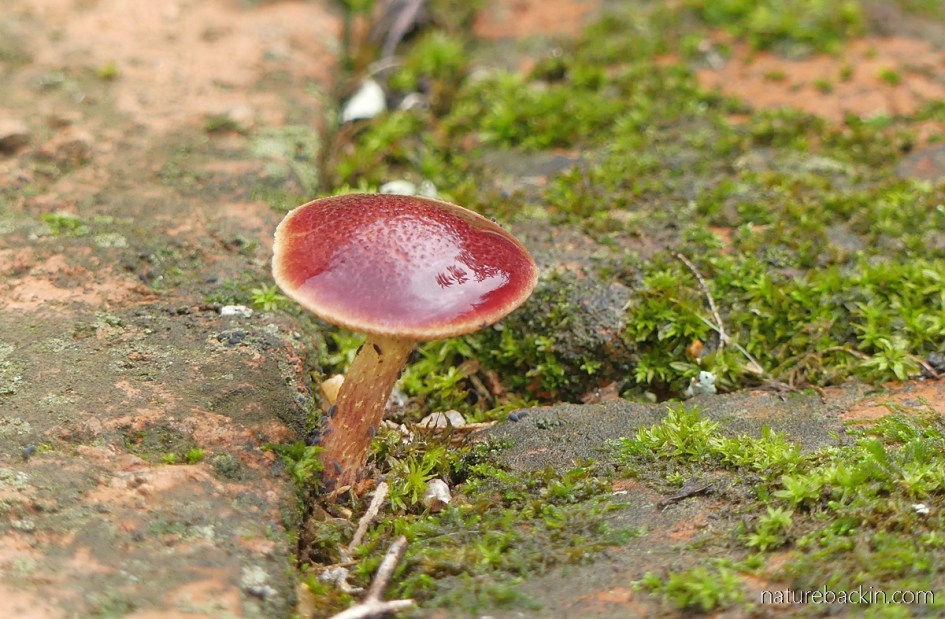
Growing in association with the orange mushroom is this redder mushroom. Perhaps it is a less mature version of the same mushroom. Some mushrooms are edible when young but become poisonous when mature. I have no idea whether these mushrooms are edible or not. Some mushrooms are inedible not because they are poisonous but because the taste horrible.
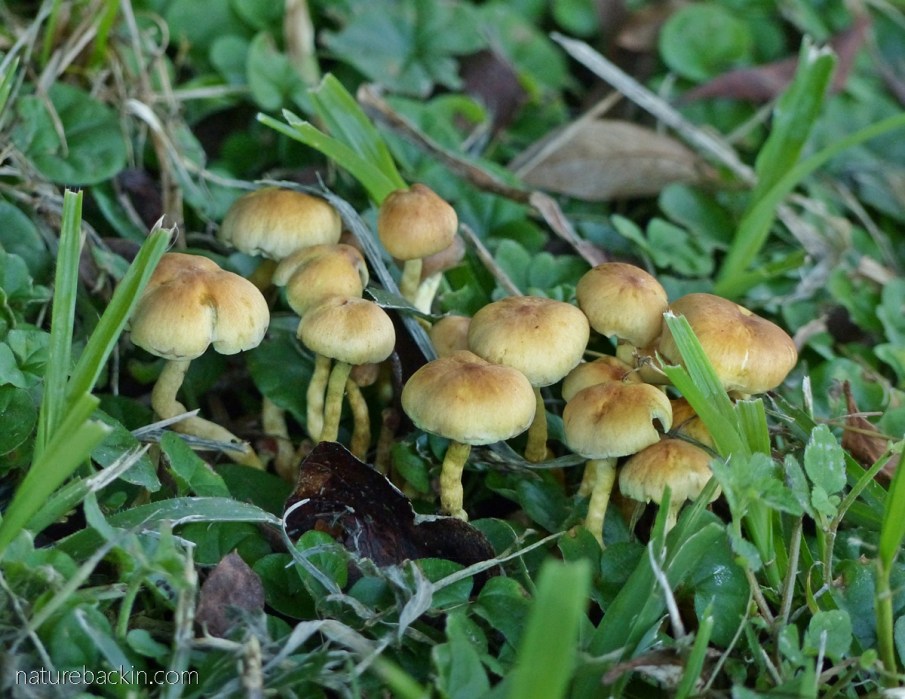
These little mushrooms grow in clusters on knobbly stems. I think they grow in association with underground roots of a dead tree.
Another grouping of fungi are parasitic fungi. Whether we regard them as good or bad depends on what they parasitize. Obviously, if they affect our garden or crop plants, think leaf blight or mildew for example, they are bad, but if they parasitize insects that we regard as pests, then we regard them as good.
Smaller forms of fungi can also be beneficial or harmful from a human point of view – of course we don’t like mouldy bread, but we like blue (mouldy) cheeses! And where would be without the fungi in the form of yeasts that ferment to make bread, and the fungi that are used to ferment wine or beer.

Although I don’t know what they are, I enjoy seeing these small mushrooms that pop up in our lawn when conditions are right for them. An American website Urban Mushrooms explains how urban mushroom foragers rather dread the enemies in their midst in the form of those who kick or stomp on mushrooms, those who poison mushrooms or mow them down, and those who pave patches of undeveloped ground that were formerly productive for edible mushrooms.
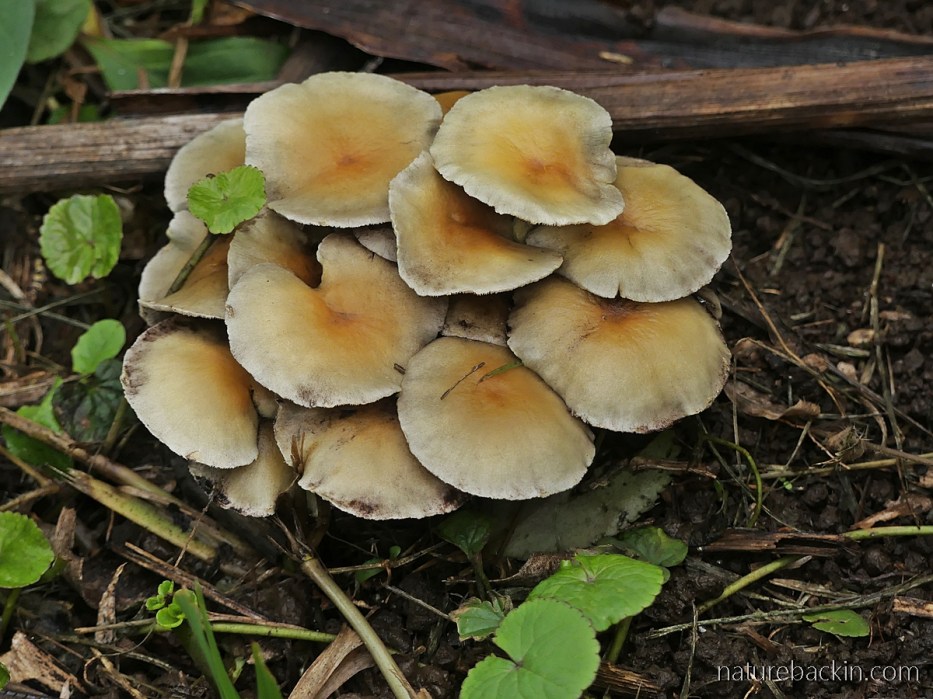
Here is another attractive cluster of mushrooms in our garden that indicate an active presence of fungal recyclers hard at work processing dead wood into healthy soil.

Some of the mushrooms that appear are delicate. Among the most delicate and tiny are the fair bonnets (or fairy incaps). I published a post featuring these lovely little mushrooms in January 2017. I titled the post Fairy-tale fungi: The magic of mushrooms and it continues to be the most visited post on naturebackin, attracting thousands of views.
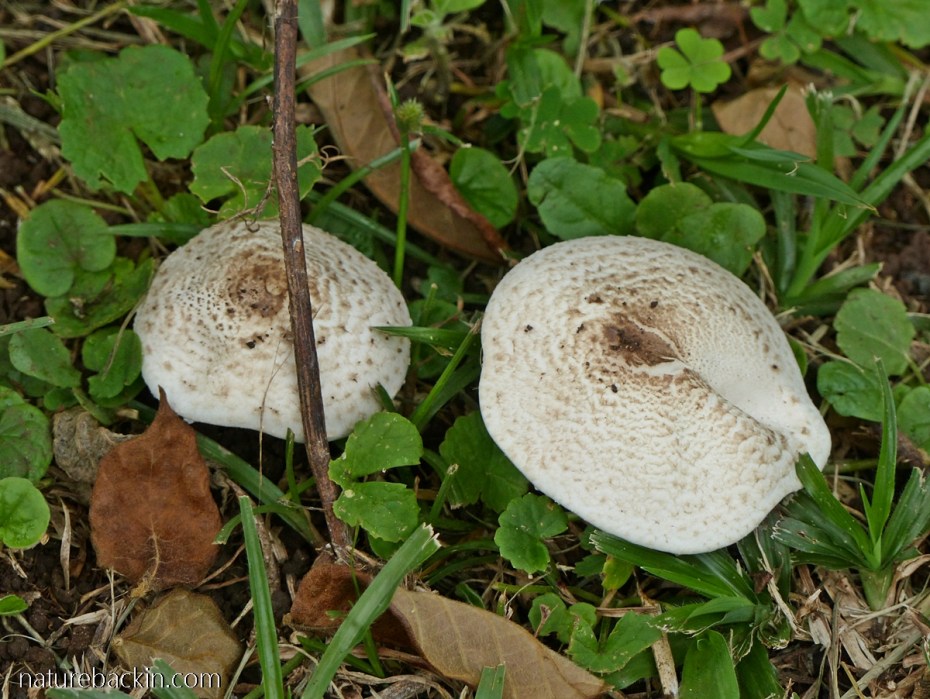
Other mushrooms that appear are more robust and I do wonder sometimes if any of them are edible, but I am far too ignorant and cautious to ever experiment.

Next week’s post will feature some other forms of fungi that appear in our garden.
Source:
Goldman, Gary B & Marieka Gryzenhout. 2019. Field Guide to Mushrooms & other Fungi of South Africa. Struik Nature: Cape Town.
Posted by Carol









July 18, 2021 at 12:53 pm
You seem to have an amazing variety of fungi in your garden. You’ve encouraged me to see what I can find in ours.
LikeLiked by 1 person
July 20, 2021 at 6:56 pm
I hope you find some, and perhaps on your woodland walks too?
LikeLiked by 1 person
July 21, 2021 at 7:56 am
Indeed. And the husband of one of my friends is a fungus nerd. He’s always happy to help with identification
LikeLiked by 1 person
July 22, 2021 at 2:12 pm
I wish I knew of a fungus nerd around here. I think firsthand experience and not just books and websites are essential when it comes to identifying fungi.
LikeLiked by 1 person
July 22, 2021 at 3:43 pm
Absolutely. He has a room in their house dedicated to All Things Mushroom.
LikeLiked by 1 person
July 10, 2021 at 2:12 pm
I thoroughly enjoyed this informative fungi post, Carol, thank you. Although I admire the mushrooms that appear wherever I walk, I do not know much about them, so I found your essay very interesting. I did not know, for example, that specific fungi associate with specific host plants. Your words have a mesmerizing effect as you carry us from one point to the next, and the photos here are truly delightful. So many species and all so beautiful. Thank you.
LikeLiked by 1 person
July 11, 2021 at 8:00 pm
Thanks Jet. I also admire fungi seem when I am out walking even though I know little about them and find trying to identify them rather intimidating. However, it is good to observe more carefully and notice more of the remarkable details.
LikeLiked by 1 person
July 10, 2021 at 11:02 am
I enjoyed reading about the fungi in your garden, and feel somewhat heartened that you too find it hard to identify some of them. In the absence of a suitable field guide I really find it hard to ID the ones I find. Your mention of amakhowe in one of your comments. They are truly amazing, both inn size and in flavour! They were truly a special treat when we found them, which was on a rare occasion.
LikeLiked by 1 person
July 11, 2021 at 7:57 pm
I find fungi can be hard to identify – for one thing, they can differ at various stages of maturity. My guidebook takes into account so many aspects when identifying them, including smell and small variations that can only be checked if one has a specimen to hand rather than just a photo.
Glad to know you have also had the pleasure of tasting amakhowe – truly a wonderful experience as you say.
LikeLiked by 1 person
July 6, 2021 at 2:00 am
What an AMAZING collection of mushrooms in your yard! And, as usual, your pics are fab! We gather mainly just one type of mushroom here. It has a red top, but I do not know its name. Looking forward to your next post.
Julie
LikeLiked by 1 person
July 9, 2021 at 10:15 am
Thanks Julie. You are fortunate to be able to gather wild mushrooms,
LikeLike
July 5, 2021 at 4:55 am
I love mushrooms! You brought back memories of hunting them as a kid. We’d pick them and bring them to an adult who knew the ones that were edible. These were folks who had arrived as refugees from WW II. Looking back I can’t help but wonder that the knowledge translated to this new environment. 🍄 of course these days there are restrictions to such hunting. I just wish I’d had the sense to learn more when I had the chance.
LikeLiked by 1 person
July 5, 2021 at 2:01 pm
It is good to have those memories from your childhood. I am learning that mushrooms are surprisingly cosmopolitan so to an extent the knowledge can be suitable elsewhere. (The nicest wild mushrooms I have had in SA were foraged and cooked by a young guy from Austria!)
I should think that some restrictions on mushroom foraging are necessary.
I suppose that many of us have regrets for opportunities we neglected to make the most of when we were young!
LikeLiked by 1 person
July 4, 2021 at 8:17 am
I love your variety of fungies! I am looking forward to your next post!
LikeLiked by 1 person
July 4, 2021 at 7:59 pm
Thanks Simone. The variety of fungi out there is stunning.
LikeLiked by 1 person
July 3, 2021 at 6:43 am
Fascinating subject and great photos. I love seeing the fantastic variety of fungi but am a bit leery about sampling them because I know nothing about them.
LikeLiked by 1 person
July 4, 2021 at 7:58 pm
Thanks Graham – definitely best to err on the side of caution …
LikeLiked by 1 person
July 2, 2021 at 3:52 pm
Thank you for your impeccable research and beautiful photographs.
One of the abiding joys of Hogsback is the boletus that appears magically after rains. It is easy to identify (with its sponge gills) and delicious to eat.
LikeLiked by 1 person
July 4, 2021 at 7:57 pm
Thanks Mariss.
Great to be able to enjoy wild mushrooms at Hogsback – and to be able to identify them too!
LikeLiked by 1 person
July 2, 2021 at 12:14 pm
I’m always delighted when fungi suddenly appear in our garden. Another enlightening post, Carol!
LikeLiked by 1 person
July 2, 2021 at 3:03 pm
Hi Sandra – I am happy to hear that you also delight in finding fungi 🙂
LikeLiked by 1 person
July 2, 2021 at 11:51 am
Great post😁😁
LikeLiked by 1 person
July 2, 2021 at 3:02 pm
Thanks Rainbow!
LikeLike
July 3, 2021 at 5:15 pm
My pleasure😊😊
LikeLiked by 1 person
July 2, 2021 at 9:51 am
Lovely post and series of photos, Carol. You sure have a lot of fungi in your garden. I always find fungi quite enigmatic, and a treat if I manage to catch those fruiting bodies which can appear over night and then just vanish like they were never there at all.
LikeLiked by 2 people
July 2, 2021 at 3:00 pm
Thank you Pete. Enigmatic is a good word for fruiting fungi. Its no wonder they have an ancient association with faeries and other supernatural presences!
LikeLiked by 1 person
July 2, 2021 at 6:17 am
I love this blog on Fungi! You have such a wide variety, evidence that you have a healthy eco-garden and of course the correct conditions. Most fungi only appear when there has been enough rainfall and the substrates are moist enough for growth. Thank you Carol for sharing the magic of your garden fungi! xxx
LikeLiked by 2 people
July 2, 2021 at 2:58 pm
Thanks Christeen. We leave a lot of dead wood and leaf litter around – the fungi are then able to produce their magic! Mostly in the summer of course, after rains as you say xxx
LikeLiked by 1 person
July 2, 2021 at 5:56 am
Aaah I love it when the little white button mushrooms pop up in my garden and thanks to my dad, who taught me, I have been fortunate to add some to breakfast on the odd occasion. But certainly would not venture further than that without my pops to guide me.
Beautiful post Aunty Carol. ❤️
LikeLiked by 1 person
July 2, 2021 at 2:56 pm
That’s wonderful – not only to have the mushrooms but to be able to know they are safe to eat and to be able to enjoy them. I expect you had amakhowe mushrooms in the Eastern Cape? They are the most marvelous mushrooms I have ever tasted. We could do with some of your dad’s knowledge here. Thanks Debs ❤️
LikeLike
July 2, 2021 at 3:57 am
I share both your fascination with fungi – am always delighted to find some growing in our garden – and your caution for they are marvels of nature that remain a mystery to me. One of the first neighbours we met when we moved here was an old man who asked if he could pick the mushrooms that had sprung up all over our lawn after a rainy period – he was used to doing so. I recall him trying to explain how to tell that these mushrooms were edible and encouraged me to try some, even offering to leave some for me. I declined.
LikeLiked by 2 people
July 2, 2021 at 2:50 pm
They are a marvel and definitely have an air of mystery. I have eaten wild mushrooms in the company of those who are experienced mushroom foragers – in turn they learnt from people who know their mushrooms. The taste of the wild mushrooms was extraordinary and delicious – commercially grown mushrooms don’t begin to compare! But I don’t know any expert foragers round here unfortunately …
LikeLiked by 1 person
July 2, 2021 at 2:05 am
What an amazing variety, Carol, and all in your garden!
LikeLiked by 2 people
July 2, 2021 at 2:45 pm
It is very pleasing to see so many different kinds. And there are more to follow!
LikeLiked by 1 person
July 3, 2021 at 2:21 am
Nice to have a second helping to look forward to!
LikeLiked by 1 person
July 2, 2021 at 12:51 am
Fungi– where would we be without them? Non-existent, methinks!
LikeLiked by 2 people
July 2, 2021 at 2:44 pm
Absolutely!
LikeLike